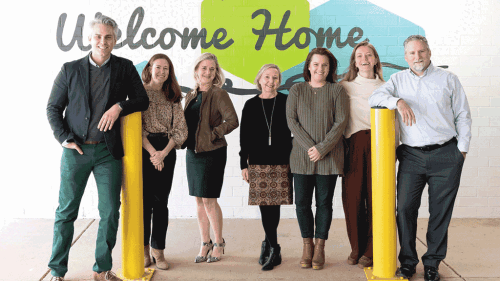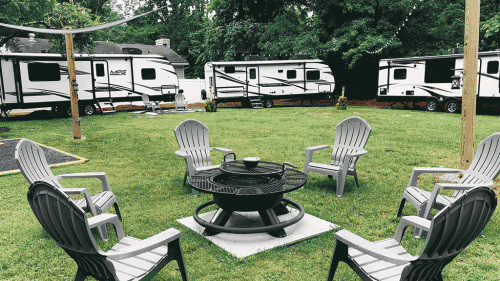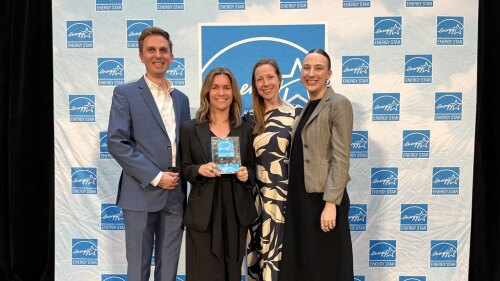Klyde Warren Park, a 5.2-acre (2.1 ha) deck park built over the recessed Woodall Rodgers Freeway in Dallas, has received national recognition as the winner of the 2014 Urban Land Institute (ULI) Urban Open Space Award. The announcement of the award selection—an annual tribute to successful large- and small-scale public spaces that have socially enriched their surrounding communities and revitalized their economies—was made today at the 2014 ULI Fall Meeting in New York City.
The award is given to the individual or organization most responsible for the creation and upkeep of the winning open space project. An international jury—representing several facets of development expertise including finance, architecture, land planning and development, public affairs, design, and professional services—selected Klyde Warren Park from an elite group of finalists.
The other finalists included the Columbus Commons and Scioto Mile in Columbus, Ohio; Guthrie Green in Tulsa, Oklahoma; Railyard Park + Plaza in Santa Fe, New Mexico; and Washington Park in Cincinnati, Ohio.
Klyde Warren Park is an urban green space owned and managed by the nonprofit Woodall Rodgers Park Foundation, formed by the Dallas business community. The park’s vision, designed by OJB–the Office of James Burnett, was spurred by a study in 2002 that confirmed the feasibility of a “deck park” over the freeway. Built with a combination of public and private funds, the Klyde Warren Park features a flexible, pedestrian-oriented design that includes a children’s park, reading room, great lawn, restaurant, performance pavilion, fountain plaza, games area, dog park, and botanical garden arranged around a sweeping pedestrian promenade. Klyde Warren Park is Dallas’s new town square that has literally and figuratively bridged the city’s downtown cultural district with the burgeoning mixed-use neighborhoods to the north, reshaping the city and catalyzing economic development.
Klyde Warren Park and the four other finalists were selected from an impressive collection of entries, representing urban areas throughout North America. While landscape architecture and urban design were factors in the judging, the jury selected finalists based on a broader set of criteria, including overall project design and how each affected or revived their surrounding areas.
“This year’s submissions reflect innovative ways that North American cities are financing and developing public destinations that create recreational experiences for residents, spur economic activity on adjacent sites, and often preserve historical and cultural heritage as well,” said jury chair M. Leanne Lachman, president of real estate consulting firm Lachman Associates in New York City. “Perhaps more important, the design and popularity of these urban open space projects signal the industry’s shift to building successful healthy places and helping encourage physical behavior through design.”
The other four finalists, with the project’s owners and designers in parentheses, were as follows:
- Columbus Commons and Scioto Mile, Columbus, Ohio (project owners: city of Columbus and Capitol South Community Urban Redevelopment Corporation; project designers: MKSK [formerly MSI], EDGE, and Moody Nolan)—In 2002, the city of Columbus tapped both the Columbus Downtown Development Corporation (CDDC) and Capitol South to help attract both residents and businesses to the downtown area and retain them there. After careful consideration, plans were made to develop two new parks—Columbus Commons, in place of a desolate mall, and Scioto Mile, which involved narrowing a thoroughfare along the Scioto River and renovating an existing park. At seven acres (2.8 ha), Columbus Commons features formal gardens, a carousel, native trees, two cafés with ample seating, and a state-of-the-art performing arts pavilion. The 11-acre (4.4 ha) Scioto Mile features a multiuse trail, swings, benches, fountains, and seating pavilions along a promenade that leads to the showpiece of the park—a 15,000-square-foot (1,400 sq m) interactive water feature adjacent to a café and stage.
- Guthrie Green, Tulsa, Oklahoma (project owner: George Kaiser Family Foundation; project designer: SWA Group)—Guthrie Green, a project built and managed by the George Kaiser Family Foundation (GKFF), transforms a 2.6-acre (1 ha) truck loading facility into a lively and highly programmed urban park. The space offers an outdoor amphitheater, a performance stage, interactive fountains, and an 11,000-square-foot (1,000 sq m) café pavilion. Sustainable components—including walking paths over bioswales, an underground geo-exchange system that powers nearby nonprofits, and a series of water features—are intended as catalysts for discovery. The park has become the area’s leading destination since its 2012 opening, drawing 3,000 people every week to daily park activities and sparking $150 million investment in a variety of public, commercial, and residential projects within the emerging 19-block Brady Arts District of downtown Tulsa.
- The Railyard Park and Plaza, Santa Fe, New Mexico (project owner: city of Santa Fe, New Mexico; project designers: Workshop: Ken Smith Landscape Architect; Frederic Schwartz Architects; and Mary Miss, artist)—Built in 1880, the original railyard was a key component of Santa Fe’s identity. The city of Santa Fe, with the help of the Trust for Public Land, purchased the land and undertook a long public process of planning, design, and implementation. The resulting Railyard Park + Plaza is the culmination of two decades of community activism that enabled citizens to retain control over the largest downtown development to conserve the open space in perpetuity as a community asset emphasizing local cultures, businesses, and artists. The site’s public promenade, art galleries, museums, a farmer’s market, brewery, restaurants, retail shops, office space, and the commuter rail station create a thriving mixed-use space that contributes to the local economy. The park includes a reflective circular ramada, walkways aligned with former rail tracks, biking and health trails, a children’s playground, picnic areas, a performance green, orchards, and teaching gardens.
- Washington Park, Cincinnati, Ohio (project owner: Cincinnati Park Board; project designer: Human Nature Inc.)—Washington Park was a cemetery before the city purchased the land in 1855, reinterred the remains elsewhere, and turned it into a park. It has served as a park ever since, but in recent decades suffered from disinvestment and criminal activity. Recognizing the value of the neighborhood’s historic buildings and the negative impact of the criminal element on the business district, the Cincinnati Center City Development Corporation (3CDC) and the city of Cincinnati began to turn the neighborhood around, ultimately leading Washington Park through a $48 million renovation that would transform the neighborhood. Today, the eight-acre (3.2 ha) park has been called the most democratic site in the region, attracting all strata of socioeconomics and demographics to its varied features, including a grand civic lawn the size of a football field, a permanent performance stage, a 7,000-square-foot (650 sq m) water feature with 130 pop jets, a renovated Civil War–era bandstand, an enclosed children’s playground, and a fenced-in dog park.
The award was created through the generosity of Amanda M. Burden, former New York City planning commissioner and 2009 laureate of the ULI J.C. Nichols Prize for Visionaries in Urban Development. In 2011, the Kresge Foundation, MetLife Foundation, and ULI Foundation joined forces to continue the Urban Open Space Award through 2015.





